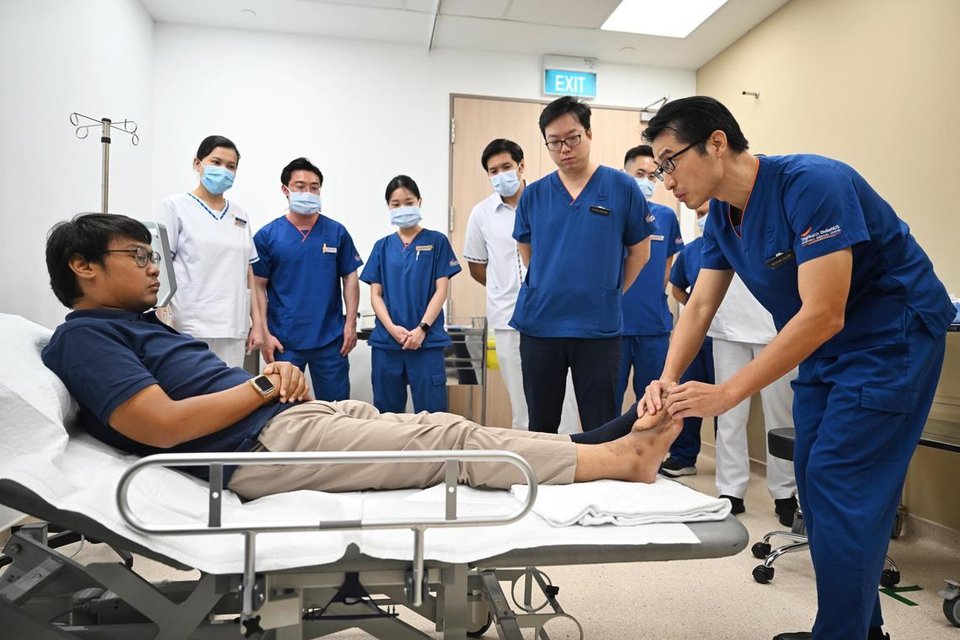Digital technology cuts treatment time, margin of error for removable partial dentures

Published on
13 Sep 2024
Published by
The Straits Times
SINGAPORE – Retired nurse Lim Soon Lian, 65, has been wearing dentures since she was 18.
“I fell in school and lost my two front teeth. It was so bad that my jaw was swollen. It was not very nice for a young woman without her front teeth, so I had partial dentures made,” she said.
Unlike full dentures, which replace all the teeth in the upper or lower jaw, partial dentures replace just some teeth.
But Madam Lim’s old dentures were a bane – uncomfortable and causing pain whenever she ate. So, when she had to extract two teeth in November 2023, she wanted new dentures made as well.
Dr Phang Zi Ying, her dentist at the National Dental Centre Singapore (NDCS), persuaded her to participate in a clinical trial, where a new smart digital method is used to make metal-based removable partial dentures (RPDs).
These dentures have a metal framework that holds the artificial teeth in place and attaches to the patient’s natural teeth.
The conventional method of creating such dentures entails casting the metal manually, which is labour-intensive and requires four visits by the patient, before a fifth visit for the final fitting.
The process can take two to four weeks, and, even then, the final product often still fits poorly.
In the trial between 2020 and 2023, dental software called SmartRPD was used to analyse 90 patients’ dental scans and generate 3D models of each patient’s metal base or framework.
Each metal base is then 3D-printed and acrylic artificial teeth and pink gum are fitted on by a technician, with the digital process helping to ensure the teeth are the right size and colour.
The process streamlines workflows and cuts down on labour and technical resources, said Assistant Professor Yu Na, the lead principal investigator from NDCS in the trial.
Using digital technology also improves fitting accuracy, cutting the error rate from between 20 per cent and 30 per cent in the conventional method, to about 3 per cent.
“It will cut down on the number of visits a patient has to make before the final fitting from five to just three,” Dr Yu said.
The trial was conducted by dentists and researchers from NDCS and the Institute of High Performance Computing (IHPC) at the Agency for Science, Technology and Research.
“While a trained dental technician needs to create one metal framework in 11 hours, the total time taken by the smart digital method to fabricate 30 RPD framework cases is three hours,” said Dr See Toh Yoong Liang, who heads the Department of Restorative Dentistry at NDCS.
“The technician can run the printer overnight and return the next morning to the completed work,” Dr See Toh added.
“Dentures treatment is not a one-off treatment... Most dentures need to be replaced and depending on the type and structure, it is anywhere between three and 10 years.”
With demand for RPDs set to rise due to Singapore’s ageing population and high prevalence of edentulism, or loss of teeth, among seniors, Dr Yu said the conventional method cannot meet the demand.
“There is a need to change the current practice of low efficiency, imprecise, labour-intensive approach to a higher throughput, better quality and automatic solution,” she said.
Dr Lim Chi Wan, principal scientist at IHPC, said having software that enhances the efficiency of custom-made RPDs allows dentists to focus on the more important tasks at hand – patient care.
The team will begin phase two of the clinical trial later in 2024 with 300 patients from 40 clinics.
As in the first phase, the patients will get their customised dentures free. Eventually, the team aims to integrate the service into the community.
The research is funded by the Ministry of Health (MOH) through the National Medical Research Council, MOH Holdings and Temasek Foundation.
As for Madam Lim, she is all smiles. “This is my fourth and the best fitting by far. I could chew properly and eating has become a joy. Previously, others could tell that my two front teeth were fake. Now they look very natural.”
Source: The Straits Times © SPH Media Limited. Reproduced with permission.
ALL views, content, information and/or materials expressed / presented by any third party apart from Council For Third Age, belong strictly to such third party. Any such third party views, content, information and/or materials provided herein are for convenience and/or general information purposes only. Council For Third Age shall not be responsible nor liable for any injury, loss or damage whatsoever arising directly or indirectly howsoever in connection with or as a result of any person accessing or acting on any such views, content, information and/or materials. Such third party views, content, information and/or materials do not imply and shall not be construed as a representation, warranty, endorsement and/or verification by Council For Third Age in respect of such views, content, information and/or materials.







